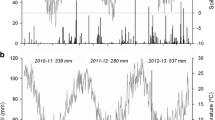Abstract
Rainfed rice (Oryza sativa L.)-based cropping systems are characterized by alternate wetting and drying cycles as monsoonal rains come and go. The potential for accumulation and denitrification of NO3 − is high in these systems as is the production and emission of CH4 during the monsoon rice season. Simultaneous measurements of CH4 and N2O emissions using automated closed chamber methods have been reported in irrigated rice fields but not in rainfed rice systems. In this field study at the International Rice Research Institute, Philippines, simultaneous and continuous measurements of CH4 and N2O were made from the 1994 wet season to the 1996 dry season. During the rice-growing seasons, CH4 fluxes were observed, with the highest emissions being in organic residue-amended plots. Nitrous oxide fluxes, on the other hand, were generally nonexistent, except after fertilization events where low N2O fluxes were observed. Slow-release N fertilizer further reduced the already low N2O emissions compared with prilled urea in the first rice season. During the dry seasons, when the field was planted to the upland crops cowpea [Vigna unguiculata (L.) Walp] and wheat (Triticum aestivum L.), positive CH4 fluxes were low and insignificant except after the imposition of a permanent flood where high CH4 fluxes appeared. Evidences of CH4 uptake were apparent in the first dry season, especially in cowpea plots, indicating that rainfed lowland rice soils can act as sink for CH4 during the upland crop cycle. Large N2O fluxes were observed shortly after rainfall events due to denitrification of accumulated NO3 −. Cumulative CH4 and N2O fluxes observed during this study in rainfed conditions were lower compared with previous studies on irrigated rice fields.
Similar content being viewed by others
References
Aulakh MS, Doran JW, Walters DT, Mosier AR & Francis DD (1991) Crop residue type and placement effects on denitrification and mineralization. Soil Sci Soc Am J 55:1010–1025
Bronson KF & Mosier AR (1993) Nitrous oxide emissions and methane consumption in wheat and corn-cropped systems in northeastern Colorado. p 133–144. In: L. Harper (ed) Agroecosystem Effects on Trace Gases and Global Climate Change. American Society of Agronomy, Madison, Wisconsin
Bronson KF & Mosier AR (1994) Suppression of methane oxidation in aerobic soil by nitrogen fertilizers, nitrification inhibitors, and urease inhibitors. Biol Fertil Soils 17:263–268
Bronson KF, Neue H, Singh U & Abao Jr, E (1997a) Automated chamber measurements of methane and nitrous oxide flux in a flooded rice soil: I. Residue, nitrogen, and water management. Soil Soc Am J 61:981–987
Bronson KF, Neue H, Singh U & Abao Jr, E (1997b) Automated chamber measurements of methane and nitrous oxide flux in a flooded rice soil: II. Fallow period emissions. J Soil Sci Soc Am 61:988–993
Buresh RJ, Woodhead T, Shepherd KD, Flordelis E & Cabangon R (1989) Nitrate accumulation and loss in mungbean lowland rice cropping system. Soil Sci Soc Am J 53:477–482
Cai ZC, Xing GX, Yan XY, Xu H, Tsuruta H, Yagi K & Minami K (1997) Methane and nitrous oxide emissions from rice paddy fields as affected by nitrogen fertilizers and water management. Plant Soil 196:7–14
Delgado JA & Mosier AR (1996) Mitigation alternatives to decrease nitrous oxide emissions and urea-nitrogen loss and their effect on methane flux. J Environ Qual 25:1105–1111
Eichner MJ (1990) Nitrous oxide emissions from fertilized soils: Summary of available data. J Environ Qual 19:272–280
George T, Ladha JK, Buresh RJ & Garrity DP (1993) Nitrate dynamics during the aerobic phase in lowland rice-based cropping systems. Soil Sci Soc Am J 57:1526–1532
Granli T & Bockman OC (1994) Nitrous oxide from agriculture. Norwegian J Agric Sci ( ):7–16
IPCC--Intergovernmental Panel on Climate Change (1992) Climate change. The supplementary report to the IPCC scientific assessment. Cambridge University Press, New York.
IRRI--International Rice Research Institute (1998) IRRI Rice Almanac, (2nd ed) Manila, Philippines, 181 p
Keller M, Mitre ME & Stallard RF (1990) Consumption of atmospheric methane in soils of Central Panama: effects of agricultural development. Global Biogeochem Cycles 4:21–27
Lidstrom ME & Stirling DI (1990) Methanotrophs: genetics and commercial applications. Annu Rev Microbiol 44:27–58
Minami K (1994) Effect of nitrification inhibitors and slowrelease fertilizer on emissions of nitrous oxide from fertilized soils. pp 187–196. In: CH4 and N2O: Global Emissions and Controls from Rice Fields and Other Agricultural and Industrial Sources, National Institute of Agro-Environmental Sciences, Tsukuba, Japan
Neue, H, Lantin RS, Wassmann R, Aduna JB, Alberto CR & Andales MJF (1994) Methane emission from rice soils off the Philippines. pp 55–63. In: K. Minami, A. Mosier, & R. Sass (eds) CH4 and N2O-Global Emissions and Controls from Rice Fields and Other Agricultural and Industrial Sources. National Institute of Agro-Environmental Sciences, Tsukuba, Japan
Rodhe H (1990) A comparison of the contribution of various gases to the greenhouse effect. Science 248:1217–1219
SAS Institute Inc (1987) SAS user's guide: Statistics. Cary, NC
Sass R, Fischer FM, Wang YB, Turner FT & Jund MF (1990) Methane emission from rice fields as influenced by solar radiation, temperature, and straw incorporation. Global Biogeochem Cycles 5:335–350
Singh JS, Raghubanshi AS, Reddy VS, Singh S & Kashyap AK (1998). Methane flux from irrigated paddy and dryland rice fields, and from seasonally dry tropical forest and savanna soils of India. Soil Biol Biochem 30:135–139
Singh S, Singh JS & Kashyap AK (1999) Methane consumption by soils of dryland rice agriculture: Influence of varieties and N-fertilization. Chemosphere 38:175–189
Tripathi BP, Ladha JK, Timsina J & Pascua SR (1997) Nitrogen dynamics and balance in intensified rainfed lowland rice-based cropping systems. Soil Sci Soc Am J 61:812–821
Yagi K & Minami K (1990) Effect of organic matter application on methane emission from some Japanese rice fields. Soil Sci Plant Nutr 36:599–610
Author information
Authors and Affiliations
Rights and permissions
About this article
Cite this article
Abao, E., Bronson, K., Wassmann, R. et al. Simultaneous Records of Methane and Nitrous Oxide Emissions in Rice-Based Cropping Systems under Rainfed Conditions. Nutrient Cycling in Agroecosystems 58, 131–139 (2000). https://doi.org/10.1023/A:1009842502608
Issue Date:
DOI: https://doi.org/10.1023/A:1009842502608




